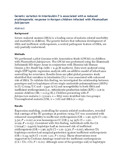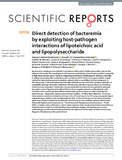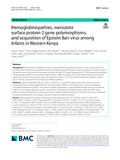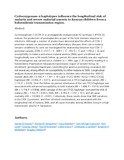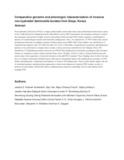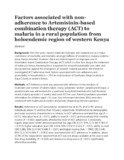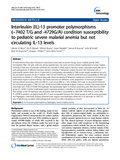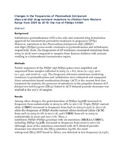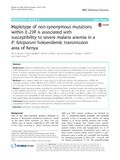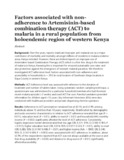Search
Now showing items 11-20 of 34
Genetic variation in interleukin-7 is associated with a reduced erythropoietic response in Kenyan children infected with Plasmodium falciparum
(BMC Med Genet., 2019-08-16)
Background
Severe malarial anemia (SMA) is a leading cause of malaria-related morbidity and mortality in children. The genetic factors that influence development of SMA and inefficient erythropoiesis, a central pathogenic ...
Direct detection of bacteremia by exploiting host-pathogen interactions of lipoteichoic acid and lipopolysaccharide
(Scientific Reports, 2019-04-17)
Bacteremia is a leading cause of death in sub-Saharan Africa where childhood mortality rates are the highest in the world. The early diagnosis of bacteremia and initiation of treatment saves lives, especially in high-disease ...
Human NCR3 gene variants rs2736191 and rs11575837 alter longitudinal risk for development of pediatric malaria episodes and severe malarial anemia
(Springer Link, 2023-09-13)
Background
Plasmodium falciparum malaria is a leading cause of pediatric morbidity and mortality in holoendemic transmission areas. Severe malarial anemia [SMA, hemoglobin (Hb) < 5.0 g/dL in children] is the most common ...
Cyclooxygenase-2 haplotypes influence the longitudinal risk of malaria and severe malarial anemia in Kenyan children from a holoendemic transmission region.
(Journal of Human Genetics, 2019-10-29)
Cyclooxygenase-2 [(COX-2) or prostaglandin endoperoxide H2 synthase-2 (PTGS-2)] induces the production of prostaglandins as part of the host-immune response to infections. Although a number of studies have demonstrated the ...
Comparative genomic and phenotypic characterization of invasive non-typhoidal Salmonella isolates from Siaya, Kenya
(PLOS ONE, 2021-01-01)
Non-typhoidal Salmonella (NTS) is a major global health concern that often causes bloodstream infections in areas of the world affected by malnutrition and comorbidities such as HIV and malaria. Developing a strategy to ...
Factors associated with non-adherence to Artemisinin-based combination therapy (ACT) to malaria in a rural population from holoendemic region of western Kenya
(National Library of Medicine, 2012-06-24)
Background: Over the years, reports implicate improper anti-malarial use as a major contributor of morbidity and mortality amongst millions of residents in malaria endemic areas, Kenya included. However, there are limited ...
Interleukin (IL)-13 promoter polymorphisms (-7402 T/G and -4729G/A) condition susceptibility to pediatric severe malarial anemia but not circulating IL-13 levels
(BMC Imunology, 2013-03-25)
n holoendemic Plasmodium falciparum transmission areas such as western Kenya, severe malarial anemia [SMA, hemoglobin (Hb) < 6.0 g/dL, with any density parasitemia] is the most common clinical manifestation of severe malaria ...
Changes in the frequencies of Plasmodium falciparum dhps and dhfr drug-resistant mutations in children from Western Kenya from 2005 to 2018: the rise of Pfdhps S436H
(Malaria Journal, 2020-10-22)
Background
Sulfadoxine-pyrimethamine (SP) is the only anti-malarial drug formulation approved for intermittent preventive treatment in pregnancy (IPTp). However, mutations in the Plasmodium falciparum dhfr (Pfdhfr) and ...
Haplotype of non-synonymous mutations within IL-23R is associated with susceptibility to severe malaria anemia in a P. falciparum holoendemic transmission area of Kenya
(BMC Infectious Diseases volume, 2017-04-20)
Background
Improved understanding of the molecular mechanisms involved in pediatric severe malarial anemia (SMA) pathogenesis is a crucial step in the design of novel therapeutics. Identification of host genetic susceptibility ...
Factors associated with non-adherence to Artemisinin-based combination therapy (ACT) to malaria in a rural population from holoendemic region of western Kenya
(National Library of Medicine, 2012-06-24)
Background: Over the years, reports implicate improper anti-malarial use as a major contributor of morbidity and mortality amongst millions of residents in malaria endemic areas, Kenya included. However, there are limited ...

